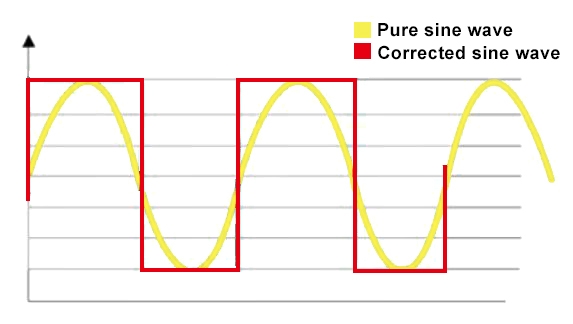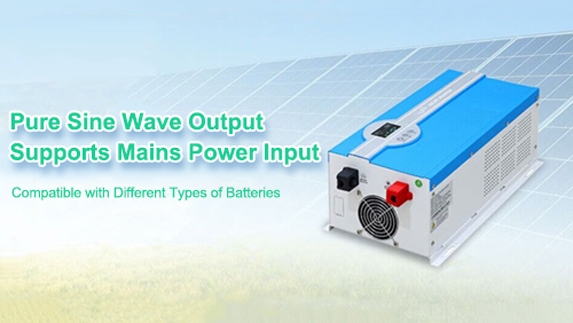In the field of power electronics, an inverter is a device that can convert direct current (DC) to alternating current (AC). And among the types of inverters, pure sine wave inverter and modified sine wave inverter are two common types. In this article, we will analyze these two types of inverters from several angles to help readers better understand the difference between them.
Output Waveform
The output waveform of a pure sine wave off grid inverter is consistent with the AC waveform of the utility grid, showing a smooth sinusoidal waveform. This waveform has lower harmonic content, which is more friendly to the operation of electrical equipment, and can prolong the service life of the equipment and reduce the failure rate.
The output waveform of the modified sine wave inverter, on the other hand, presents a stepped square wave or an approximate sine wave. The harmonic content of this waveform is high, which may cause some interference to the normal operation of electrical equipment, especially for some equipment with high requirements on current waveform (such as audio, TV, etc.).
When the output waveform of the stand-alone inverter is square wave and correction wave, there are high harmonics in the output current of the inverter in addition to the fundamental wave, and the high harmonic currents will produce additional losses such as eddy currents on inductive loads, which will lead to serious heating of the components, which is not conducive to the safety of electrical equipment. The harmonic distortion of square wave inverter is about 40%, which is only suitable for resistive loads; the harmonic distortion of modified wave inverter is less than 20%, which is suitable for most of the loads; the harmonic distortion of sinusoidal wave inverter is less than 3%, and the quality of its waveforms is better than that of the utility grid, which can be applied to all AC power loads.

Efficiency and Cost
Pure sine wave inverters usually use advanced power electronics technology, with high conversion efficiency and stability. However, due to its technical complexity and high manufacturing cost, the price is usually higher.
In contrast, Modified Sine Wave inverters are relatively inexpensive due to their technological sophistication and low manufacturing cost. However, due to the limitation of its output waveform, its conversion efficiency and stability may be slightly lower than that of a pure sine wave inverter.
Applications
Since the output waveform of pure sine wave inverter is closer to the AC waveform of utility grid, it is suitable for all kinds of electrical equipments, especially for some equipments with higher requirements on current waveform. In addition, pure sine wave inverter is also a better choice in some occasions which need to run stably for a long time or have higher requirements on power quality (such as hospitals, data centers, etc.).
While the modified sine wave inverter is suitable for some occasions that are more sensitive to cost or have less high requirements on power quality (such as outdoor camping, temporary power use, etc.). In addition, in some simple power systems, repair sine wave inverters can also be used as a backup power supply.
Maintenance
Pure sine wave inverters and modified sine wave inverters are also different in maintenance and upkeep. Due to the high technical complexity of pure Sine wave inverters, they require regular professional maintenance and upkeep to ensure their normal operation and prolong their service life. On the other hand, the technology of the modified sine wave inverter is more mature and the structure is relatively simple, so it is more convenient to maintain and repair.
By analyzing the output waveforms, efficiency and cost, applications, and maintenance and repair of pure sine wave inverters and modified sine wave inverters, we can find that they differ in many aspects. When choosing which inverter to use, comprehensive consideration should be made based on actual needs and budget. For the occasions which need to run stably for a long time or have higher requirements on power quality, pure sine wave inverters, 2kW off grid solar inverter, 10kW off grid solar inverter, can be chosen; while for some occasions which are more sensitive to cost or have less high requirements on power quality, modified sine wave inverters can be chosen.

Below, we'll take a look at each of them, starting with their individual characteristics.
Pure Sine Wave Off-Grid Inverter
A pure sine wave inverter is a type of inverter in which the output current waveform conforms exactly to a sine wave. It converts electrical energy from a DC power source, such as a battery or solar cell, into AC electrical energy to provide a stable AC power source for home, commercial and industrial equipment. The output current waveform of a pure sine wave inverter is of high quality, and low harmonic distortion can be achieved when interfacing with grid power.
Pure sine wave inverters have the following characteristics:
- Good output waveform quality: The output voltage waveform of a pure sine wave inverter is of very high quality, almost comparable to the mains power supply. This is very important for some devices that require high power quality (such as high-precision instruments, inverters, motors, etc.).
- Stable electrical performance: Pure sine wave inverters can provide stable output voltage and frequency with low voltage fluctuation and frequency error. This makes pure sine wave inverters ideal for equipment and systems that require high power stability.
- Wide range of applications: The output waveform of a pure sine wave inverter can meet the power supply requirements of most electronic devices and can be used in a variety of applications such as domestic. It's an important piece of equipment for off-grid living.
Modified Sine Wave Off-Grid Inverter
Modified sine wave inverter is a kind of inverter whose output current waveform is close to sinusoidal waveform, but compared with pure sine wave inverter, its current waveform has certain distortion. Modified sine wave inverter realizes waveform control by controlling the conduction and truncation times of switching elements such as thyristors and transistors.
Modified sine wave inverter has the following characteristics:
- Large distortion of output waveform: The output waveform of modified sine wave inverter has large distortion compared with the output waveform of pure sine wave inverter. Usually, the waveform of the modified sine wave inverter contains more harmonic components, which may cause interference to some induction motors, audio equipment, frequency converters, etc.
- Relatively low efficiency: Due to manufacturing costs and technical limitations, the efficiency of modified sine wave inverters is usually low. Their conversion efficiencies are usually in the range of 80% to 90%, which is slightly lower compared to pure sine wave inverters.
- Limited range of application: Due to the large distortion in the output waveform of modified sine wave inverters, their range of application is relatively narrow. Usually, this kind of inverter is suitable for some relatively low requirement devices, such as TV, computer, lamps and so on.
(1).png)
(1).png)